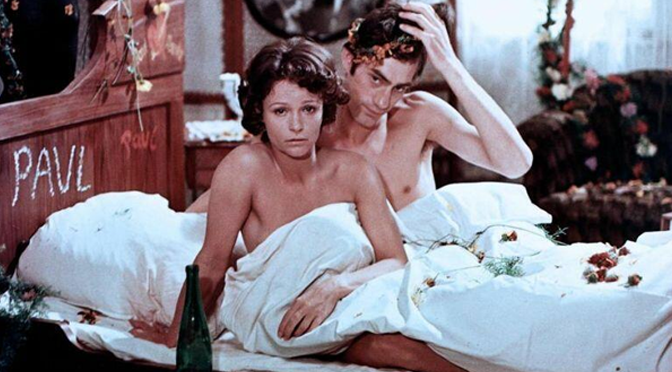What is the difference between eroticism and pornography? I think of Reiner Kunze. In his book “The lovely years,” he tells of the uproar that the film “The Legend of Paul and Paula” caused in his town at the time. The film was accused of being pornography. Yet naked skin was actually nothing special in GDR cinema of the 1970s.
The reviewers based their criticism primarily on a love scene in which Paula, played by Angelica Domröse, prepares a bed of blossoms for her boyfriend Paul (Winfried Glatzeder) and – after an epicurean picnic on this very bed – sprinkles him with salt and pepper before the two make tender love. The scene is replete with symbolic intercuts. Among other things, one in which Paula’s female ancestors try to tear the cloth off her, who is clad only in a veil. The makers of the film probably already suspected that this would lead to accusations of pornography. Not for nothing do they have one viewer angrily exclaim during this scene, “That’s pornography!” To which another laconically retorts, “Then look away.”
Reiner Kunze picks up on this in his prose collection “The lovely years.” In it, he tells of a dialogue between himself and a friend:
“The film is supposedly pornography. Because of the flowers in bed, and because she puts the wreath on him naked…. The teachers soon burst.” […]
“Pornography?”, I said. “Because a woman dumps half a wagon of flowers on the bed out of joy for the man she loves? And because she’s not expecting him in a winter coat?”
“So it’s not porn?” She placed the guitar between her knees and crossed her arms in front of the fretboard.
“In porn, people appear because genitals need feet.”
I love that phrase: In pornography, people appear because genitals need feet. It stuck with me when I first read it many years ago. And it’s still the criterion I use today to decide whether something is erotic or pornographic: Is it just about putting sexual parts in the limelight, or do I learn something about the people having sex with each other in a story?
Sure, there’s pornographic literature, too. But as a rule, every story lives from conflict. And that presupposes that different people with different desires and needs collide. That they experience their sexuality consciously, that is, with all five senses. Maybe I’m a little naive. But I think the attempt to write purely pornographic literature is doomed to failure from the start. What would come out would be a boring string of positions. Or in the words of Raymond Chandler: It would read about as exciting as a railroad timetable.
I don’t even want to get into the question of how much plot an erotic story needs. It depends on the genre and the target audience. Romance readers certainly want more background information about the protagonists than consumers of BDSM literature. At least that’s what Jade K. Scott claims in her book, The Six-Figure Erotica Author: How I Make Six Figures Self-Publishing Erotica.
For me and my way of writing, however, it is crucial that I want to tell stories about people. That doesn’t exclude explicit scenes. On the contrary. I think it’s mendacious to only hint at or sultrily paraphrase the actual act. Today, we have the opportunity to tell about what happens between two people, relatively free of guardians of virtue. It may be that in a few years the wind will be blowing from a different direction and new moralists will forbid us to publish. But as long as we can, we should take the chance and write about sexuality in an honest, sensual way.
All the best to you,
Sandra

